Physical Address
304 North Cardinal St.
Dorchester Center, MA 02124
Physical Address
304 North Cardinal St.
Dorchester Center, MA 02124
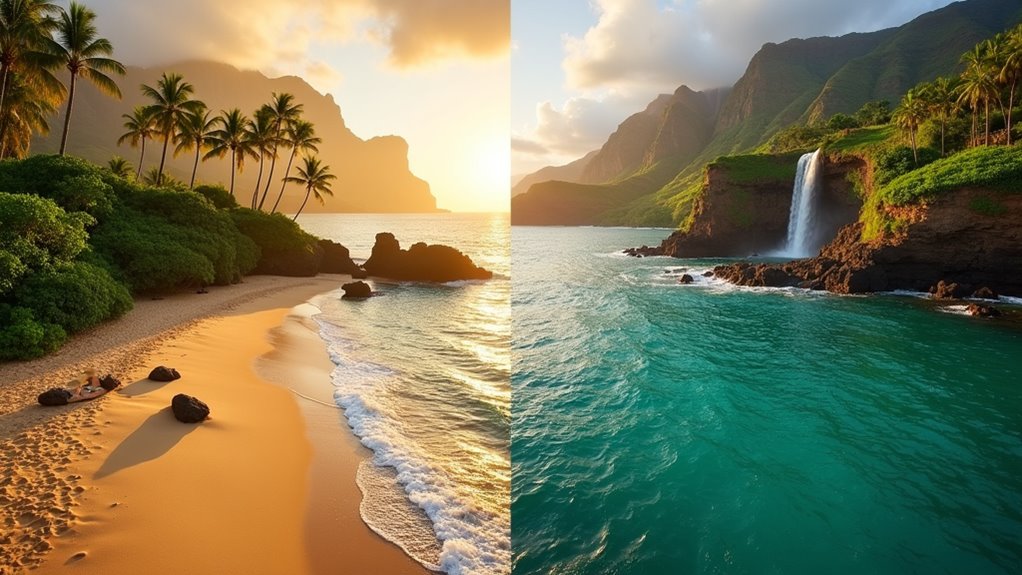
Mysterious Hawaiian paradises await: Lanai offers exclusive luxury while Kauai delivers adventure, but which island matches your dream vacation?
Kauai offers diverse landscapes, extensive hiking trails, and varied accommodation options from budget to luxury. You’ll find bustling beaches, the famous Kalalau Trail, and a vibrant food scene. Lanai provides a more exclusive experience with luxury resorts, secluded beaches, and fewer crowds in its small-town atmosphere of just 3,283 residents. Your choice depends on whether you prefer adventure and variety (Kauai) or tranquility and upscale experiences (Lanai). Let’s explore what makes each island uniquely appealing for different travelers.
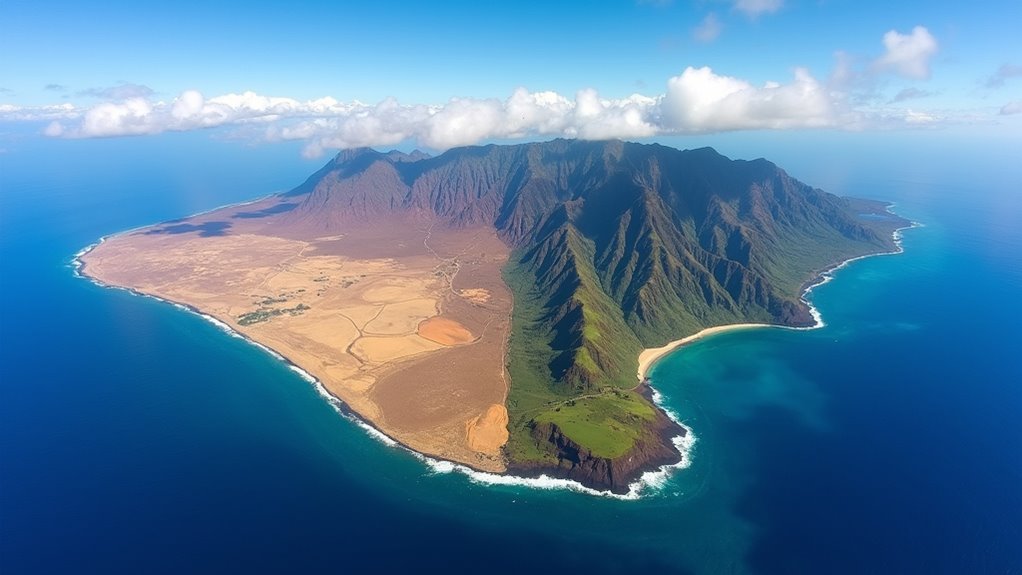
When deciding between Lanai and Kauai, size makes a significant difference in your vacation experience. Kauai, the fourth-largest Hawaiian island at 552.3 square miles, offers diverse landscapes with beaches, rainforests, and mountains.
In contrast, Lanai is much smaller at 140.5 square miles, making it the sixth-largest island and the smallest publicly accessible inhabited island in Hawaii.
Location-wise, you’ll find Kauai northwest of Oahu, while Lanai sits southeast of Molokai and east of Maui, separated by the Kalohi and Auau Channels. Hawaii consists of over 140 islands that make up the entire state, with travelers primarily visiting just the six largest ones.
Both islands are accessible by air and sea, but Lanai’s more secluded position makes it less commercially developed than Kauai.
This difference is evident in Lanai’s rural character—it doesn’t even have traffic lights!
When swimming in the waters around either island, you might encounter Hawaiian sharks, which include nine key species found throughout the archipelago’s waters.
The population differences between Lanai and Kauai dramatically shape your island experience. With just 3,283 residents, Lanai City offers a genuine small-town atmosphere where you’ll encounter markedly fewer crowds than on Kauai.
Escape the crowds and discover authentic island life in Lanai’s intimate community of just 3,283 residents.
This population disparity means you’ll likely enjoy more personal interactions with locals on Lanai. The median age is 40.3 years and diverse racial groups include Asian (48.9%), multiracial (22.1%), and Islander (10.9%) residents. Lanai’s community has experienced impressive 17.2% population growth in the last five years, indicating its increasing appeal while still maintaining its intimate charm.
The island’s intimate size makes transportation simpler and attractions more accessible.
While both islands provide tourist infrastructure, Lanai’s facilities are more concentrated and can feel more exclusive. Visitors can explore top snorkeling spots around the island with far fewer swimmers competing for views of the vibrant marine life. If you’re seeking authentic community events, family-run eateries, and a less commercialized Hawaiian experience, Lanai’s smaller population footprint offers distinct advantages over more populous Kauai.
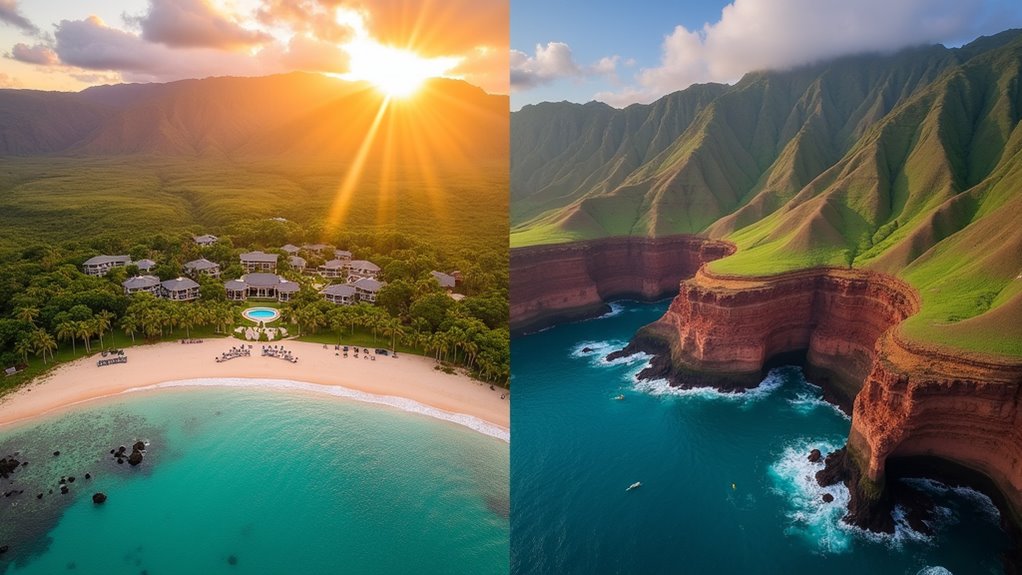
Choosing between Lanai and Kauai presents a clear contrast in tourism experiences that will considerably impact your Hawaiian vacation. Lanai caters to those seeking exclusivity and high-end amenities, while Kauai offers greater variety for different budgets and interests.
If you’re planning a one week itinerary, Kauai offers more varied attractions to fill your daily schedule than the purposefully limited options on Lanai.
Recent tourism data shows that Lanai has experienced significant declines in visitor numbers, while Kauai has maintained relatively stable tourism levels.
Both Lanai and Kauai boast spectacular beaches that showcase Hawaii’s diverse coastal beauty, each offering unique experiences that reflect the distinct character of these islands.
On Lanai, you’ll find secluded gems like Polihua Beach, accessible only by 4×4, and Hulopoe Beach with its calm waters. Hulopoe Beach Park has been designated as a Marine Life Conservation District, protecting its abundant underwater ecosystem from fishing and taking. Don’t miss Huawai Bay’s distinctive salt-and-pepper sand or Shipwreck Beach’s historical allure.
Kauai counters with the picturesque Hanalei Bay, perfect for surfing enthusiasts, and family-friendly Poipu Beach. For adventure seekers, hike to Kalalau Beach for stunning Na Pali Coast views or visit Tunnels Beach for world-class snorkeling. Oahu enthusiasts often recommend Tunnels Beach as one of Hawaii’s premier snorkeling destinations for its diverse marine life.
While Lanai offers more seclusion and unique geological features, Kauai provides better accessibility and superior surfing conditions. Both islands deliver unforgettable marine life encounters.
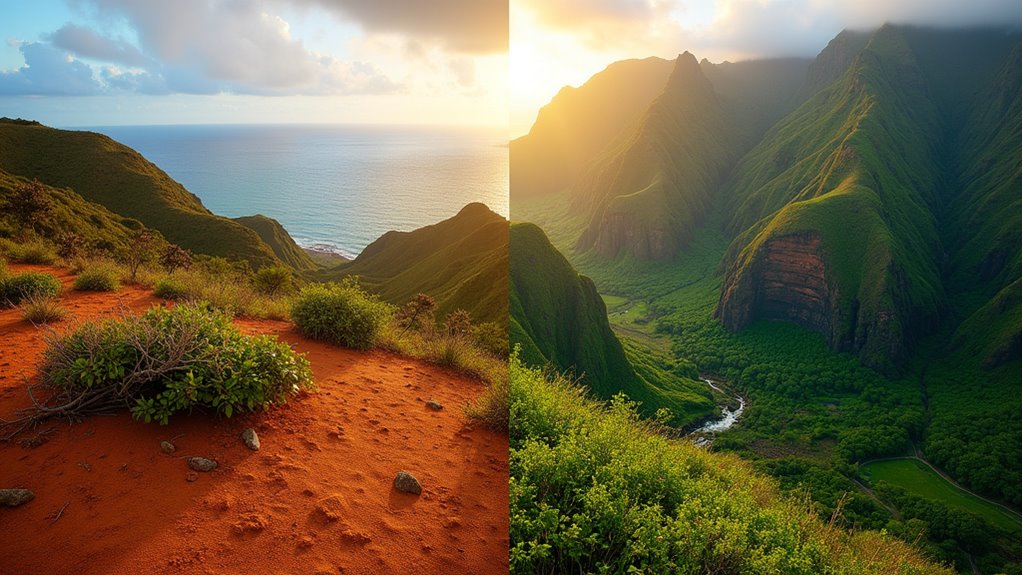
While both Hawaiian islands captivate visitors with stunning natural landscapes, Kauai outshines Lanai for serious hikers and outdoor enthusiasts. Known as the “Garden Isle,” Kauai offers dramatically more diverse and extensive trail options than Lanai.
When planning your outdoor adventures, consider these key differences:
When it comes to finding the perfect place to stay, Kauai and Lanai offer dramatically different experiences for travelers. Kauai provides remarkable variety, from luxury resorts to affordable condos, vacation rentals, and cottages spread across four distinct regions.
Lanai, by contrast, focuses on exclusivity with primarily high-end options like the Four Seasons, where rooms typically start at $800+ per night. Lanai’s exceptionally limited lodging inventory consists of only 2 main hotels and a small town, creating its distinctive exclusive atmosphere.
While Kauai’s luxury properties command similar rates, you’ll also find condos and vacation rentals between $200-$500 nightly.
Both islands require advance bookings, especially during peak seasons, but Kauai offers more flexibility for last-minute deals. Travelers choosing between these islands should consider their vacation priorities when deciding which Hawaiian paradise best matches their accommodation needs.
If you’re seeking diverse pricing options and locations, Kauai wins; if exclusive luxury and seclusion are your priority, Lanai delivers—at a premium.
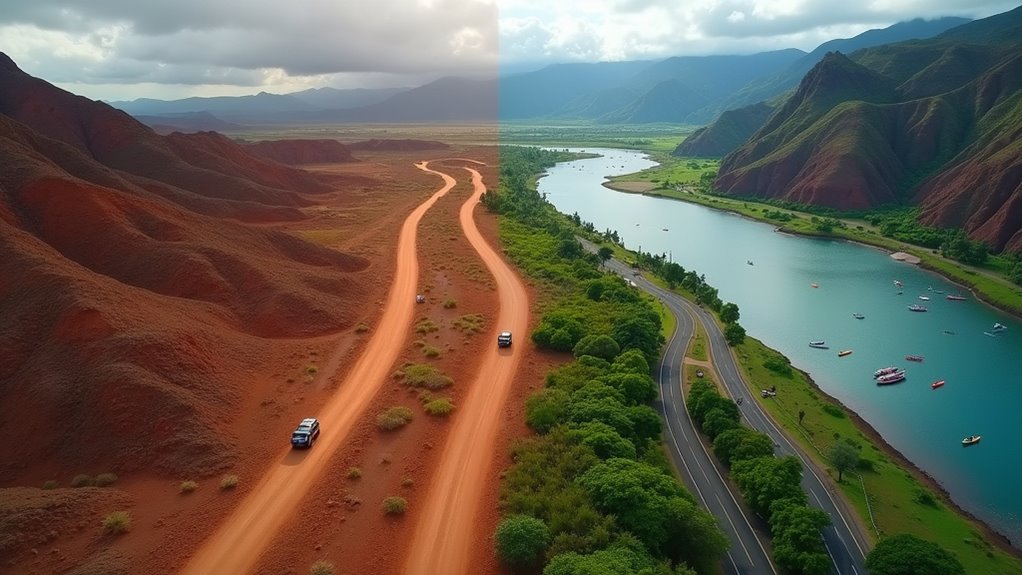
Getting between and around Lanai and Kauai presents distinct logistical challenges that substantially impact your Hawaiian island experience. Inter-island travel requires strategic planning, with flights connecting through Oahu or Maui being your primary option between these islands. Many visitors make Oahu a stopover destination as it serves as the main hub for inter-island transportation.
Navigating between these islands demands careful orchestration—your Hawaiian adventure’s success hinges on mastering inter-island logistics.
The culinary landscapes of Lanai and Kauai offer dramatically different experiences for food-loving travelers.
On Kauai, you’ll find incredible diversity – from casual food trucks and local markets to upscale farm-to-table restaurants. The island’s food scene focuses on authentic local dining, prioritizing freshness over resort experiences. Must-try spots include Kaloa Fish Market for poke, Kilauea Fish Market for fish tacos, and Bar Acuda for Hawaiian tapas. The island boasts budget-friendly options alongside gourmet experiences. Visitors can sample traditional Hawaiian dishes like poi, kalua pig, and lomi salmon that showcase the islands’ rich culinary heritage.
Lanai’s food scene is more limited but luxurious, centered around high-end resort dining. Four Seasons Lanai houses exceptional restaurants like Nobu and One Forty, offering curated tasting menus and wine pairings. Independent eateries are scarce, and prices generally skew toward the premium end.
Both islands emphasize fresh seafood and local ingredients, but Kauai provides more accessibility and variety for everyday dining.
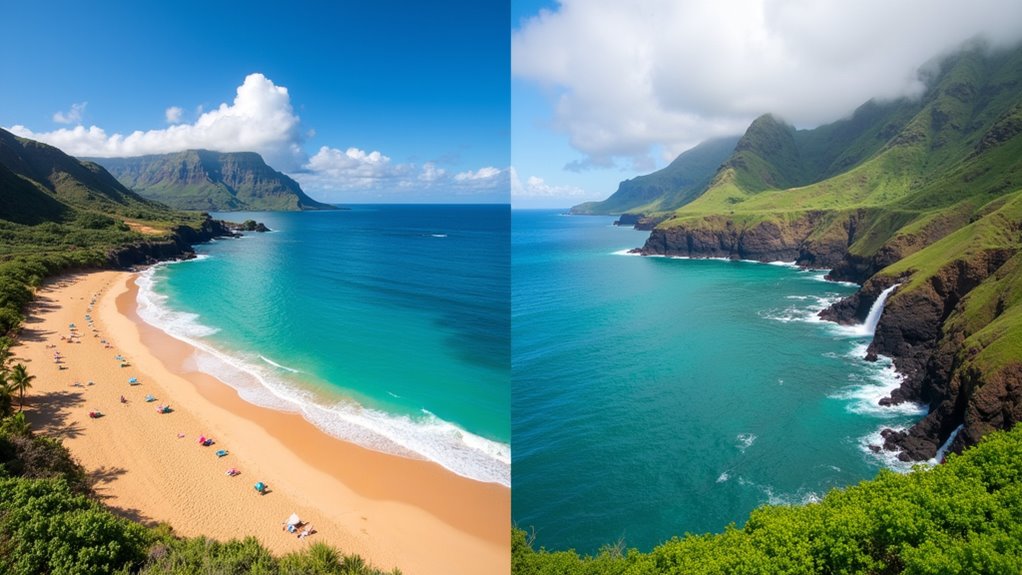
Just as choosing where to eat influences your Hawaiian experience, selecting the right time to visit can make all the difference between a dream vacation and a disappointing one. Lanai and Kauai both offer tropical climates, but with distinct seasonal variations.
Fall provides excellent opportunities for exploring Lanai’s cultural and historical sites with fewer tourist crowds.
If you’re interested in a quieter, less commercialized experience, consider visiting Molokai island as an alternative to the more developed Hawaiian destinations.
Understanding the cultural tapestry of each Hawaiian island adds profound depth to your vacation experience.
On Lanai, you’ll find intimate cultural connections at the Lānaʻi Culture & Heritage Center, ancient Hawaiian structures at Kaunolu Village, and petroglyphs that tell stories of the past. The island embraces traditions through hula performances, luaus, and the spirit of aloha that permeates daily life. Visitors can explore the ruins of a prehistoric Hawaiian Village at Kaunolū Fishing Village to gain insights into traditional island life.
Kauai offers diverse cultural experiences along the Wailua River, at the Kauai Museum, and through the preserved plantation history of Old Koloa Town. Traditional hula, music, and family-oriented gatherings showcase the island’s heritage. Unlike the urban atmosphere of Honolulu, Kauai maintains a more rustic charm that appeals to those seeking authentic Hawaiian culture.
Both islands maintain strong community engagement in preserving their cultural identities, though Lanai’s smaller size creates more intimate cultural exchanges with visitors.
Whether you choose Lanai’s intimate luxury or Kauai’s diverse adventures, you’ll find your perfect Hawaiian paradise. Like a master chef offering both a refined tasting menu and a vibrant buffet, these islands serve different experiences but equal satisfaction. Remember, over 80% of repeat Hawaiian visitors say they discovered something unexpected on their trip. Your best choice isn’t between islands—it’s between different versions of paradise.